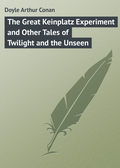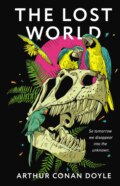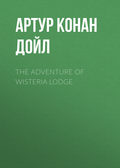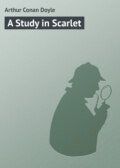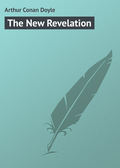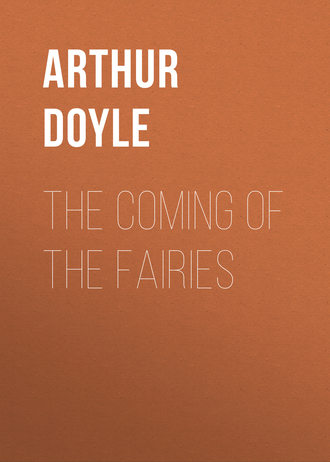
Артур Конан Дойл
The Coming of the Fairies
"I could have wished that Mr. Maurice Hewlett's somewhat playful criticism of the genuineness of the photographs of fairies appearing in the Strand Magazine Christmas number had been more clearly defined. The only serious point raised is the difference between photographic and pictorial representation of motion – Mr. Hewlett maintaining that the latter is in evidence in the photographs.
"With regard to the separate photographs of the sites, surely the reason for their inclusion is obvious. Photographic experts had stated that though the two negatives revealed no trace of any faking process (such as double exposure, painted figures on enlargements rephotographed, set-up models in card or other material), still it could not be held to be impossible to obtain the same class of result by very clever studio work. Also, certain points that needed elucidation were the haze above and at the side of the child's head, and the blurred appearance of the waterfall as compared with the clarity of the figures, etc. An inspection of the spots and photographs of their surroundings was surely the only way to clear up some of these. As a matter of fact, the waterfall proved to be about twenty feet behind the child, and hence out of focus, and some large rocks at the same distance in the rear, at the side of the fall, were found to be the cause of the haziness. The separate photographs, of which only one is published of each place, confirm entirely the genuineness of the sites – not the genuineness of the fairies.
"In commenting on the photography of a moving object, Mr. Hewlett makes the astonishing statement that at the instant of being photographed it is not in motion (Mr. H.'s italics). I wonder when it is, and what would happen if a camera was exposed then! Of course the moving object is in motion during exposure, no matter whether the time be a fiftieth or a millionth part of a second, though Mr. Hewlett is by no means the only one to fall into this error. And each of the fairy figures in the negative discloses signs of movement. This was one of the first points determined.
"I admit at once, of course, that this does not meet the criticism that the fairies display much more grace in action than is to be found in the ordinary snapshot of a moving horse or man. But if we are here dealing with fairies whose bodies must be presumed to be of a purely ethereal and plastic nature, and not with skeleton-framed mammals at all, is it such a very illogical mind that accepts the exquisite grace therein found as a natural quality that is never absent? In view of the overwhelming evidence of genuineness now in hand this seems to be the truth.
"With regard to the last query raised – the child looking at the camera instead of at the fairies – Alice was entirely unsophisticated respecting the proper photographic attitude. For her, cameras were much more novel than fairies, and never before had she seen one used so close to her. Strange to us as it may seem, at the moment it interested her the most. Apropos, would a faker, clever enough to produce such a photograph, commit the elementary blunder of not posing his subject?"
Among other interesting and weighty opinions, which were in general agreement with our contentions, was one by Mr. H. A. Staddon of Goodmayes, a gentleman who had made a particular hobby of fakes in photography. His report is too long and too technical for inclusion, but, under the various headings of composition, dress, development, density, lighting, poise, texture, plate, atmosphere, focus, halation, he goes very completely into the evidence, coming to the final conclusion that when tried by all these tests the chances are not less than 80 per cent. in favour of authenticity.
It may be added that in the course of exhibiting these photographs (in the interests of the Theosophical bodies with which Mr. Gardner is connected), it has sometimes occurred that the plates have been enormously magnified upon the screen. In one instance, at Wakefield, the powerful lantern used threw an exceptionally large picture on a huge sheet. The operator, a very intelligent man who had taken a sceptical attitude, was entirely converted to the truth of the photographs, for, as he pointed out, such an enlargement would show the least trace of a scissors irregularity or of any artificial detail, and would make it absurd to suppose that a dummy figure could remain undetected. The lines were always beautifully fine and unbroken.
CHAPTER IV
THE SECOND SERIES
When Mr. Gardner was in Yorkshire in July, he left a good camera with Elsie, for he learned that her cousin Frances was about to visit her again and that there would be a chance of more photographs. One of our difficulties has been that the associated aura of the two girls is needful. This joining of auras to produce a stronger effect than either can get singly is common enough in psychic matters. We wished to make full use of the combined power of the girls in August. My last words to Mr. Gardner, therefore, before starting for Australia were that I should open no letter more eagerly than that which would tell me the result of our new venture. In my heart I hardly expected success, for three years had passed, and I was well aware that the processes of puberty are often fatal to psychic power.
I was surprised, therefore, as well as delighted, when I had his letter at Melbourne, informing me of complete success and enclosing three more wonderful prints, all taken in the fairy glen. Any doubts which had remained in my mind as to honesty were completely overcome, for it was clear that these pictures, specially the one of the fairies in the bush, were altogether beyond the possibility of fake. Even now, however, having a wide experience of transference of pictures in psychic photography and the effect of thought upon ectoplasmic images, I feel that there is a possible alternative explanation in this direction, and I have never quite lost sight of the fact that it is a curious coincidence that so unique an event should have happened in a family some members of which were already inclined to occult study, and might be imagined to have formed thought-pictures of occult appearances. Such suppositions, though not to be entirely dismissed, are, as it seems to me, far-fetched and remote.
Here is the joyous letter which reached me at Melbourne:
September 6, 1920.
My dear Doyle,
Greetings and best wishes! Your last words to me before we parted were that you would open my letter with the greatest interest. You will not be disappointed – for the wonderful thing has happened!
I have received from Elsie three more negatives taken a few days back. I need not describe them, for enclosed are the three prints in a separate envelope. The "Flying Fairy" and the "Fairies' Bower" are the most amazing that any modern eye has ever seen surely! I received these plates on Friday morning last and have since been thinking furiously.
A nice little letter came with them saying how sorry they were (!) that they couldn't send more, but the weather had been bad (it has been abominably cold), and on only two afternoons had Elsie and Frances been able to visit the glen. (Frances has now returned to Scarborough at the call of school.) All quite simple and straightforward and concluding with the hope that I might be able to spend another day with them at the end of this month.
I went over to Harrow at once, and Snelling without hesitation pronounced the three as bearing the same proofs of genuineness as the first two, declaring further that at any rate the "bower" one was utterly beyond any possibility of faking! While on this point I might add that to-day I have interviewed Illingworth's people and somewhat to my surprise they endorsed this view. (Now if you have not yet opened the envelope please do so and I will continue…)
I am going to Yorkshire on the 23rd inst. to fill some lecture engagements and shall spend a day at C., and of course take photos of these spots and examine and take away any "spoilt" negatives that will serve as useful accompaniments. The bower negative, by the way, the girls simply could not understand at all. They saw the sedate-looking fairy to the right, and without waiting to get in the picture Elsie pushed the camera close up to the tall grasses and took the snap…
To this letter I made answer as follows:
Melbourne, October 21, 1920.
Dear Gardner,
My heart was gladdened when out here in far Australia I had your note and the three wonderful prints which are confirmatory of our published results. You and I needed no confirmation, but the whole line of thought will be so novel to the ordinary busy man who has not followed psychic inquiry, that he will need that it be repeated again and yet again before he realizes that this new order of life is really established and has to be taken into serious account, just as the pigmies of Central Africa.
I felt guilty when I laid a delay-action mine and left the country, leaving you to face the consequences of the explosion. You knew, however, that it was unavoidable. I rejoice now that you should have this complete shield against those attacks which will very likely take the form of a clamour for further pictures, unaware that such pictures actually exist.
The matter does not bear directly upon the more vital question of our own fate and that of those we have lost, which has brought me out here. But anything which extends man's mental horizon, and proves to him that matter as we have known it is not really the limit of our universe, must have a good effect in breaking down materialism and leading human thought to a broader and more spiritual level.
It almost seems to me that those wise entities who are conducting this campaign from the other side, and using some of us as humble instruments, have recoiled before that sullen stupidity against which Goethe said the gods themselves fight in vain, and have opened up an entirely new line of advance, which will turn that so-called "religious," and essentially irreligious, position, which has helped to bar our way. They can't destroy fairies by antediluvian texts, and when once fairies are admitted other psychic phenomena will find a more ready acceptance.
Good-bye, my dear Gardner, I am proud to have been associated with you in this epoch-making incident. We have had continued messages at seances for some time that a visible sign was coming through – and perhaps this was what is meant. The human race does not deserve fresh evidence, since it has not troubled, as a rule, to examine that which already exists. However, our friends beyond are very long-suffering and more charitable than I, for I will confess that my soul is filled with a cold contempt for the muddle-headed indifference and the moral cowardice which I see around me.
Yours sincerely,Arthur Conan Doyle.
The next letters from Mr. Gardner told me that in September, immediately after this second series was taken, he had gone north again, and came away more convinced than ever of the honesty of the whole Wright family and of the genuine nature of the photographs. From this letter I take the following extracts:
"My visit to Yorkshire was very profitable. I spent the whole day with the family and took photographs of the new sites, which proved to be in close proximity to the others. I enclose a few prints of these. It was beside the pond shown that the 'cradle' or bower photograph was taken. The fairy that is in the air was leaping rather than flying. It had leapt up from the bush below five or six times, Elsie said, and seemed to hover at the top of its spring. It was about the fifth time that it did so that she snapped the shutter. Unfortunately, Frances thought the fairy was leaping on to her face, the action was so vigorous, and tossed her head back. The motion can be detected in the print. The fairy who is looking at Elsie in the other photograph is holding a bunch of fairy harebells. I thought this one had 'bobbed' hair and was altogether quite in the fashion, her dress is so up-to-date! But Elsie says her hair was close-curled, not bobbed. With regard to the 'cradle' Elsie tells me they both saw the fairy on the right and the demure-looking sprite on the left, but not the bower. Or rather, she says there was only a wreath of faint mist in between and she could make nothing of it. We have now succeeded in bringing this print out splendidly, and as I can get certificates from experts giving the opinion that this negative could not possibly be 'faked' we seem to be on perfectly safe ground. The exposure times in each case were one-fiftieth of a second, the distance about three to four feet, the camera was the selected 'Cameo' that I had sent to Elsie, and the plates were of those that I had sent too.
"The colours of dresses and wings, etc., I have complete, but will post these particulars on when writing at length a little later and have the above more fully written out." …
November 27, 1920.
"The photographs:
"When I was in Yorkshire in September investigating the second series, I took photos of the spots, of course, and the full account of the success. The children only had two brief hours or so of decent sunshine during the whole of that fortnight they were together in August. On the Thursday they took two and on the Saturday one. If it had been normal weather we might have obtained a score or more. Possibly, however, it is better to go slowly – though I propose we take the matter further again in May or June. The camera I had sent was the one used, and also the plates (which had all been marked privately by the Illingworth Co., independently of me). The three new fairy negatives proved to be of these and can be certified so to be by the manager. The Cradle or Bower negative is, as I think I told you, declared to be utterly unfakeable, and I can get statements to this effect…"
In a subsequent fuller account Mr. Gardner says:
"On Thursday afternoon, August 26, a fairly bright and sunny day, fortunately (for the unseasonably cold weather experienced generally could hardly have been worse for the task), a number of photographs were taken, and again on Saturday, August 28. The three reproduced here are the most striking and amazing of the number. I only wish every reader could see the superlatively beautiful enlargements made directly from the actual negatives. The exquisite grace of the flying fairy baffles description – all fairies, indeed, seem to be super-Pavlovas in miniature. The next, of the fairy offering a flower – an etheric harebell – to Iris, is a model of gentle and dignified pose, but it is to the third that I would draw special and detailed attention. Never before, or otherwhere, surely, has a fairy's bower been photographed!
"The central ethereal cocoon shape, something between a cocoon and an open chrysalis in appearance, lightly suspended amid the grasses, is the bower or cradle. Seated on the upper left-hand edge with wing well displayed is an undraped fairy apparently considering whether it is time to get up. An earlier riser of more mature age is seen on the right possessing abundant hair and wonderful wings. Her slightly denser body can be glimpsed within her fairy dress. Just beyond, still on the right, is the clear-cut head of a mischievous but smiling elf wearing a close-fitting cap. On the extreme left is a demure-looking sprite, with a pair of very diaphanous wings, while just above, rather badly out of focus, however, is another with wings still widely extended, and with outspread arms, apparently just alighting on the grass tops. The face in half profile can just be traced in a very clear and carefully toned print that I have. Altogether, perhaps, this of the bower is the most astonishing and interesting of the more successful photographs, though some may prefer the marvellous grace of the flying figure.
"The comparative lack of definition in this photograph is probably accounted for by the absence of the much denser human element. To introduce us in this way directly to a charming bower of the fairies was quite an unexpected result on the part of the girls, by the way. They saw the somewhat sedate fairy on the right in the long grasses, and, making no attempt this time to get in the picture themselves, Iris put the camera very close up and obtained the snap. It was simply good fortune that the bower was close by. In showing me the negative, Iris only remarked it as being a quaint little picture that she could not make out!"
There the matter stands, and nothing has occurred from that time onwards to shake the validity of the photographs. We were naturally desirous of obtaining more, and in August 1921 the girls were brought together once again, and the very best photographic equipment, including a stereoscopic camera and a cinema camera, were placed at their disposal. The Fates, however, were most unkind, and a combination of circumstances stood in the way of success. There was only a fortnight during which Frances could be at Cottingley, and it was a fortnight of almost incessant rain, the long drought breaking at the end of July in Yorkshire. In addition, a small seam of coal had been found in the Fairy Glen, and it had been greatly polluted by human magnetism. These conditions might perhaps have been overcome, but the chief impediment of all was the change in the girls, the one through womanhood and the other through board-school education.
There was one development, however, which is worth recording. Although they were unable to materialize the images to such an extent as to catch them upon a plate, the girls had not lost their clairvoyant powers, and were able, as of old, to see the sprites and elves which still abounded in the glen. The sceptic will naturally say that we have only their own word for that, but this is not so. Mr. Gardner had a friend, whom I will call Mr. Sergeant, who held a commission in the Tank Corps in the war, and is an honourable gentleman with neither the will to deceive nor any conceivable object in doing so. This gentleman has long had the enviable gift of clairvoyance in a very high degree, and it occurred to Mr. Gardner that we might use him as a check upon the statements of the girls. With great good humour, he sacrificed a week of his scanty holiday – for he is a hard-worked man – in this curious manner. But the results seem to have amply repaid him. I have before me his reports, which are in the form of notes made as he actually watched the phenomena recorded. The weather was, as stated, bad on the whole, though clearing occasionally. Seated with the girls, he saw all that they saw, and more, for his powers proved to be considerably greater. Having distinguished a psychic object, he would point in the direction and ask them for a description, which he always obtained correctly within the limit of their powers. The whole glen, according to his account, was swarming with many forms of elemental life, and he saw not only wood elves, gnomes, and goblins, but the rarer undines, floating over the stream. I take a long extract from his rather disjointed notes, which may form a separate chapter.
CHAPTER V
OBSERVATIONS OF A CLAIRVOYANT IN THE COTTINGLEY GLEN, AUGUST 1921
Gnomes and Fairies. In the field we saw figures about the size of the gnome. They were making weird faces and grotesque contortions at the group. One in particular took great delight in knocking his knees together. These forms appeared to Elsie singly – one dissolving and another appearing in its place. I, however, saw them in a group with one figure more prominently visible than the rest. Elsie saw also a gnome like the one in the photograph, but not so bright and not coloured. I saw a group of female figures playing a game, somewhat resembling the children's game of oranges and lemons. They played in a ring; the game resembled the grand chain in the Lancers. One fairy stood in the centre of the ring more or less motionless, while the remainder, who appeared to be decked with flowers and to show colours, not normally their own, danced round her. Some joined hands and made an archway for the others, who moved in and out as in a maze. I noticed that the result of the game appeared to be the forming of a vortex of force which streamed upwards to an apparent distance of four or five feet above the ground. I also noticed that in those parts of the field where the grass was thicker and darker, there appeared to be a correspondingly extra activity among the fairy creatures.
Water Nymph. In the beck itself, near the large rock, at a slight fall in the water, I saw a water sprite. It was an entirely nude female figure with long fair hair, which it appeared to be combing or passing through its fingers. I was not sure whether it had any feet or not. Its form was of a dazzling rosy whiteness, and its face very beautiful. The arms, which were long and graceful, were moved with a wave-like motion. It sometimes appeared to be singing, though no sound was heard. It was in a kind of cave, formed by a projecting piece of rock and some moss. Apparently it had no wings, and it moved with a sinuous, almost snake-like motion, in a semi-horizontal position. Its atmosphere and feeling was quite different from that of the fairies. It showed no consciousness of my presence, and, though I waited with the camera in the hope of taking it, it did not detach itself from the surroundings in which it was in some way merged.
Wood Elves. (Under the old beeches in the wood, Cottingley, August 12, 1921.) Two tiny wood elves came racing over the ground past us as we sat on a fallen tree trunk. Seeing us, they pulled up short about five feet away, and stood regarding us with considerable amusement but no fear. They appeared as if completely covered in a tight-fitting one-piece skin, which shone slightly as if wet. They had hands and feet large and out of proportion to their bodies. Their legs were somewhat thin, ears large and pointed upwards, being almost pear-shaped. There were a large number of these figures racing about the ground. Their noses appeared almost pointed and their mouths wide. No teeth and no structure inside the mouth, not even a tongue, so far as I could see. It was as if the whole were made up of a piece of jelly. Surrounding them, as an etheric double surrounds a physical form, is a greenish light, something like chemical vapour. As Frances came up and sat within a foot of them they withdrew, as if in alarm, a distance of eight feet or so, where they remained apparently regarding us and comparing notes of their impressions. These two live in the roots of a huge beech tree – they disappeared through a crevice into which they walked (as one might walk into a cave) and sank below the ground.
Water Fairy. (August 14, 1921.) By a small waterfall, which threw up a fine spray, was seen poised in the spray a diminutive fairy form of an exceedingly tenuous nature. It appeared to have two main colourings, the upper part of its body and aura being pale violet, the lower portion pale pink. This colouring appeared to penetrate right through aura and denser body, the outline of the latter merging into the former. This creature hung poised, its body curved gracefully backwards, its left arm held high above its head, as if upheld by the vital force in the spray, much as a seagull supports itself against the wind. It was as if lying on its back in a curved position against the flow of the stream. It was human in shape, but did not show any characteristics of sex. It remained motionless in this position for some moments, then flashed out of view. I did not notice any wings.
Fairy, Elves, Gnomes, and Brownie. (Sunday, August 14, 9 p.m. In the field.) Lovely still moonlight evening. The field appears to be densely populated with native spirits of various kinds – a brownie, fairies, elves, and gnomes.
A Brownie. He is rather taller than the normal, say eight inches, dressed entirely in brown with facings of a darker shade, bag-shaped cap, almost conical, knee breeches, stockings, thin ankles, and large pointed feet – like gnomes' feet. He stands facing us, in no way afraid, perfectly friendly and much interested; he gazes wide-eyed upon us with a curious expression as of dawning intellect. It is as if he were reaching after something just beyond his mental grasp. He looks behind him at a group of fairies who are approaching us and moves to one side as if to make way. His mental attitude is semi-dreamlike, as of a child who would say "I can stand and watch this all day without being tired." He clearly sees much of our auras and is strongly affected by our emanations.
Fairies. Frances sees tiny fairies dancing in a circle, the figures gradually expanding in size till they reached eighteen inches, the ring widening in proportion. Elsie sees a vertical circle of dancing fairies flying slowly round; as each one touched the grass he appeared to perform a few quick steps and then continued his slow motion round the circle. The fairies who are dancing have long skirts, through which their limbs can be seen; viewed astrally the circle is bathed in golden yellow light, with the outer edges of many hues, violet predominating. The movement of the fairies is reminiscent of that of the great wheel at Earl's Court. The fairies float very slowly, remaining motionless as far as bodies and limbs are concerned, until they come round to the ground again. There is a tinkling music accompanying all this. It appears to have more of the aspect of a ceremony than a game. Frances sees two fairy figures performing as if on the stage, one with wings, one without. Their bodies shine with the effect of rippling water in the sun. The fairy without wings has bent over backwards like a contortionist till its head touches the ground, while the winged figure bends over it. Frances sees a small Punch-like figure, with a kind of Welsh hat, doing a kind of dancing by striking its heel on the ground and at the same time raising his hat and bowing. Elsie sees a flower fairy, like a carnation in shape, the head appearing where the stalk touches the flower and the green sepals forming a tunic from which the arms protrude, while the petals form a skirt, below which are rather thin legs. It is tripping across the grass. Its colouring is pink like a carnation in a pale, suffused sort of way. (Written by the light of the moon.) I see couples a foot high, female and male, dancing in a slow waltz-like motion in the middle of the field. They appear even to reverse. They are clothed in etheric matter and rather ghost-like in appearance. Their bodies are outlined with grey light and show little detail.
Elsie sees a small imp reminiscent of a monkey, revolving slowly round a stalk to the top of which he was clinging. He has an impish face and is looking our way as if performing for our benefit.
The brownie appears during all this to have taken upon himself the duties of showman. I see what may be described as a fairy fountain about twenty feet ahead. It is caused by an uprush of fairy force from the ground – and spreading fish-tail fashion higher into the air – it is many-hued. This was also seen by Frances.
(Monday, August 15. In the field.) I saw three figures racing from the field into the wood – the same figures previously seen in the wood. When about a distance of ten yards from the wall they leapt over it into the wood and disappeared. Elsie sees in centre of field a very beautiful fairy figure, somewhat resembling a figure of Mercury, without winged sandals, but has fairy wings. Nude, light curly hair, kneeling down in a dark clump of grass, with its attention fixed on something in the ground. It changes its position; first it is sitting back on its heels, and then it is rising to its full kneeling height. Much larger than usual, probably eighteen inches high. It waves its arms over some object on the ground. It has picked up something from the ground (as I think a baby) and holds it to its breast and seems to be praying. Has Greek features and resembles a Greek statue – like a figure out of a Greek tragedy.
(Tuesday, August 16, 10 p.m. In the field.) By the light of a small photographic lamp.
Fairies. Elsie sees a circle of fairies tripping round, hands joined, facing outwards. A figure appears in the centre of the ring, at the same time the fairies faced inwards.
Goblins. A group of goblins came running towards us from the wood to within fifteen feet of us. They differ somewhat from the wood elves, having more the look of gnomes, though they are smaller, being about the size of small brownies.
Fairy. Elsie sees a beautiful fairy quite near; it is nude, with golden hair, and is kneeling in the grass, looking this way with hands on knees, smiling at us. It has a very beautiful face, and is concentrating its gaze on me. This figure came within five feet of us, and, after being described, faded away.
Elf. Elsie sees a kind of elf who seems to be going so fast that it blows his hair back; one can sense the wind round him, yet he is stationary, though he looks to be busily hurrying along.
Goblins. Elsie sees a flight of little mannikins, imp-like in appearance, descending slantwise on to the grass. They form into two lines which cross each other as they come down. One line is coming vertically down, feet touching head, the other comes across them shoulder to shoulder. On reaching the ground they all run off in different directions, all serious, as if intent upon some business. The elves from the wood appear to be chiefly engaged in racing across the field, though no other purpose appears to be served by their speed or presence. Few of them pass near us without pulling up to stare. The elves seem to be the most curious of all the fairy creatures. Frances sees three and calls them goblins.
Fairy. A blue fairy. A fairy with wings and general colouring of sea-blue and pale pink. The wings are webbed and marked in varying colours like those of a butterfly. The form is perfectly modelled and practically nude. A golden star shines in the hair. The fairy is a director, though not apparently with any band for the present.



